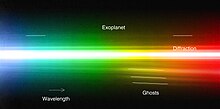HR 8799 c
HR 8799 c is an
Spectra

Near infrared spectroscopy from 995 to 1769 nanometers made with the Palomar Observatory show evidence of ammonia, perhaps some acetylene but neither carbon dioxide nor substantial methane.[9] High resolution spectroscopy with the OSIRIS instrument on the Keck Observatory show numerous well resolved lines of molecular absorption in the planet's atmosphere in the K band. Although methane is absent, the planet's atmosphere contains both water and carbon monoxide; the carbon-to-oxygen ratio of HR 8799 c is higher than that of its star, suggesting that the planet formed through the core accretion process.[10][11]
Later, in November 2018, researchers confirmed the existence of
The detection of water and carbon monoxide in the planetary atmosphere was announced in 2021.[14]
See also
Notes
- ^ Value given assuming the planet's orbit is circular and is being observed face-on.
References
- ^ S2CID 206516630.
- ^ a b
Jason, M.; C. Bergfors; M. Goto; W. Brandner; D. Lafrenière (2010). "Spatially resolved spectroscopy of the exoplanet HR 8799 c" (PDF). The Astrophysical Journal. 710 (1): L35–L38. S2CID 9159181. Retrieved 2010-01-13.
- S2CID 4425891.
- ^ "Astronomers capture first images of newly-discovered solar system" (Press release). W. M. Keck Observatory. 2008-11-13. Archived from the original on 2013-11-26. Retrieved 2008-12-02.
- ^ "Gemini Releases Historic Discovery Image of Planetary First Family" (Press release). Gemini Observatory. 2008-11-13. Retrieved 2008-12-02.
- ^ Achenbach, Joel (2008-11-13). "Scientists Publish First Direct Images of Extrasolar Planets". The Washington Post. Retrieved 2008-12-02.
- S2CID 11760422.
- Bibcode:2010eso..pres....2.Retrieved 2010-01-13.
- S2CID 7173368.
- ^ "Alien planet's atmosphere contains water and carbon monoxide". Archived from the original on 2019-03-30. Retrieved 2013-03-14.
- ^ "Giant Alien Planet in Supersized Solar System May Solve Mystery". Space.com. 2013-03-14. Archived from the original on 2023-06-07.
- EurekAlert!. Retrieved 21 November 2018.
- S2CID 119372301.
- S2CID 235898867
External links
![]() Media related to HR 8799 c at Wikimedia Commons
Media related to HR 8799 c at Wikimedia Commons
- "HR 8799 c". Exoplanets. Archived from the original on 2012-03-04. Retrieved 2008-12-02.
